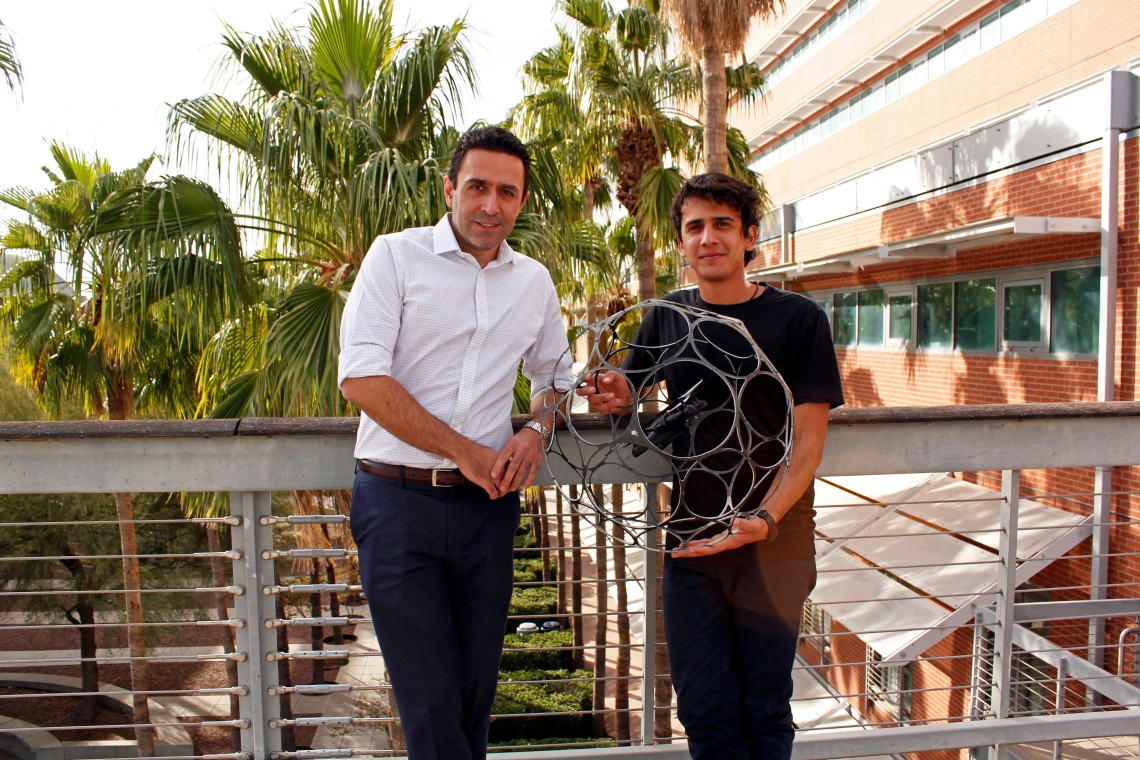Teaching Engineering By Touch
Professor and alum team up on tools to teach visually impaired students about engineering concepts.

Associate professor of aerospace and mechanical engineering Kavan Hazeli with Revolute Robotics cofounder and College of Engineering alum Sahand Sabet.
Sahand Sabet considered several applications for the rolling, flying robot that he developed as part of his PhD research and for which he co-founded a startup, Revolute Robotics. The small drone, surrounded by a durable spherical rolling cage, can monitor agricultural fields, help in search and rescue missions, and locate wildfires from a distance. It rolls to conserve energy and switches to flying in non-traversable areas and to rise above obstacles.
Kavan Hazeli, who joined the faculty of the Department of Aerospace and Mechanical Engineering at the University of Arizona in fall 2021, saw another possibility: Use the robot to teach visually impaired students about engineering.
“We never had the opportunity to get flying robots into the hands of visually impaired students because they can be dangerous,” Hazeli said. “But the way Sahand designed the robot makes it safe. Students can hold the outer part and use it to feel physical concepts, like rotation force, torque, drag and lift. A combination of these concepts can help students understand how objects can fly.”
The two researchers have teamed up and are submitting proposals to advance educational applications for the technology. They’re also considering ways the robots could be used as navigation aids for the visually impaired.
“After meeting Kavan, I pay attention to things like how blind people cross the street,” said Sabet, who was named the University of Arizona’s 2021 Student Innovator of the Year, and who partnered with Tech Launch Arizona to market the technology. “We’re trying to come up with new ideas that help them have a better life. I realized if we can help, we definitely should.”
Expanding Horizons
Hazeli’s interest in teaching visually impaired students traces back to 2015, when he was a postdoctoral fellow at the Johns Hopkins University. He was leading a summer research program for high school students, and one applicant was a clear standout: Shawn Abraham, a blind student with a statement of purpose that exuded determination. Hazeli selected Abraham for the program and began looking into tools to help teach his pupil about engineering. There weren’t any.
“There are educational tools to teach science and math to the visually impaired,” Hazeli said. “However, there are none for engineering concepts. I couldn’t explain simple engineering concepts to Shawn, and I had to build my own things.”
Hazeli did what most good engineers would have done. He improvised, using a combination of braille graphs and 3D models of atomic structures that Abraham could feel with his hands. To understand how composites combine the beneficial properties of two or more materials, Abraham bent flexible and brittle materials and felt how they were harder to break when bundled. The way these adaptations helped Abraham really “get it” stayed with Hazeli.
While on the faculty at the University of Alabama, Huntsville, he used funds from a National Science Foundation CAREER Award to create educational tools for teaching engineering concepts to visually impaired students. In 2019 and 2020, he sponsored a student design team to build a wind tunnel that incorporated touch and sound to teach lift mechanism and flight concepts.
Similar to traditional wind tunnel, it is a box through which air moves to simulate wind. Researchers use miniature aircraft models in wind tunnels to see how real aircraft behave in flight – for example, how much the wind lifts the aircraft, or how different types of airflow affect the body of the plane. The student group developed a version with an opening on top, through which part of the aircraft protrudes. Users put their hands directly on the aircraft model to feel concepts like drag and lift.
Hazeli’s partnership with Sabet and Revolute Robotics represents a commitment to expanding access to education and helping others in the community.
“We are trying to diversify the pool of applicants for engineering schools, because often visually impaired students don’t know engineering is something that’s available to them,” Hazeli said. “It’s our responsibility to develop the tools to make engineering concepts accessible to this group of learners and expand their horizons.”

